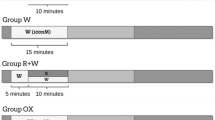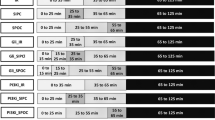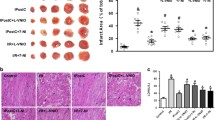Abstract
Reactive oxygen species (ROS) are important intracellular signaling molecules and are implicated in cardioprotective pathways including ischemic preconditioning. Statins have been shown to have cardioprotective effects against ischemia/reperfusion injury, however, the precise mechanisms remain to be elucidated. We hypothesized that ROS-mediated signaling cascade may be involved in pravastatin-induced cardioprotection. Cultured rat cardiomyocytes were exposed to H2O2 for 30 min to induce cell injury. Pravastatin significantly suppressed H2O2-induced cell death evaluated by propidium iodide staining and the MTT assay. Incubation with pravastatin activated catalase, and prevented a ROS burst induced by H2O2, which preserved mitochondrial membrane potential. Protective effects were induced very rapidly within 10 min, which was concordant with the up-regulation of phosphorylated ERK1/2. L-NAME, 5HD, N-acetylcysteine (NAC) and staurosporine inhibited ERK1/2 phosphorylation and also reduced pravastatin-induced cardioprotection, suggesting NO, mitochondrial KATP (mitoKATP) channels, ROS and PKC should be involved in the cardioprotective signaling. We also demonstrated that pravastatin moderately up-regulated ROS generation in a 5HD-inhibitable manner. In isolated perfused rat heart experiments, pravastatin administered 10 min prior to no-flow global ischemia significantly improved left ventricular functional recovery, and also reduced infarct size, which were attenuated by the treatment with NAC, 5HD, L-NAME or staurosporine. Administration of pravastatin from the beginning of reperfusion also conferred cardioprotection. Pravastatin protected the cardiomyocytes against oxidative stress by preventing the ROS burst and preserving mitochondrial function. Moderately up-regulated ROS production by mitoKATP channels opening is involved in the pro-survival signaling cascade activated by pravastatin.







Similar content being viewed by others
References
Node K, Fujita M, Kitakaze M, Hori M, Liao JK (2003) Short-term statin therapy improves cardiac function and symptoms in patients with idiopathic dilated cardiomyopathy. Circulation 108:839–843
Teshima Y, Yufu K, Akioka H et al (2009) Early atorvastatin therapy improves cardiac function in patients with acute myocardial infarction. J Cardiol 53:58–64
Kodama Y, Kitta Y, Nakamura T et al (2006) Atorvastatin increases plasma soluble Fms-like tyrosine kinase-1 and decreases vascular endothelial growth factor and placental growth factor in association with improvement of ventricular function in acute myocardial infarction. J Am Coll Cardiol 48:43–50
Lipinski MJ, Abbate A, Fuster V, Vetrovec GW (2007) Drug insight: statins for nonischemic heart failure—evidence and potential mechanisms. Nat Clin Pract Cardiovasc Med 4:196–205
Kloner RA, Przyklenk K, Whittaker P (1989) Deleterious effects of oxygen radicals in ischemia/reperfusion. Resolved and unresolved issues. Circulation 80:1115–1127
Hool LC (2006) Reactive oxygen species in cardiac signalling: from mitochondria to plasma membrane ion channels. Clin Exp Pharmacol Physiol 33:146–151
Das S, Otani H, Maulik N, Das DK (2006) Redox regulation of angiotensin II preconditioning of the myocardium requires MAP kinase signaling. J Mol Cell Cardiol 41:248–255
O’Rourke B (2004) Evidence for mitochondrial K+ channels and their role in cardioprotection. Circ Res 94:420–432
Pain T, Yang XM, Critz SD et al (2000) Opening of mitochondrial KATP channels triggers the preconditioned state by generating free radicals. Circ Res 87:460–466
Forbes RA, Steenbergen C, Murphy E (2001) Diazoxide-induced cardioprotection requires signaling through a redox-sensitive mechanism. Circ Res 88:802–809
Teshima Y, Akao M, Jones SP, Marbán E (2003) Cariporide (HOE642), a selective Na+/H+ exchange inhibitor, inhibits the mitochondrial death pathway. Circulation 108:2275–2281
Arrigo AP, Firdaus WJ, Mellier G et al (2005) Cytotoxic effects induced by oxidative stress in cultured mammalian cells and protection provided by Hsp27 expression. Methods 35:126–138
Shinohara T, Takahashi N, Kohno H et al (2007) Mitochondria are targets for geranylgeranylacetone-induced cardioprotection against ischemia-reperfusion in the rat heart. Am J Physiol Heart Circ Physiol 293:H1892–H1899
Kroemer G, Dallaporta B, Resche-Rigon M (1998) The mitochondrial death/life regulator in apoptosis and necrosis. Annu Rev Physiol 60:619–642
Zweier J, Talukder M (2006) The role of oxidants and free radicals in reperfusion injury. Cardiovasc Res 70:181–190
Ping P, Zhang J, Cao X et al (1999) PKC-dependent activation of p44/p42 MAPKs during myocardial ischemia-reperfusion in conscious rabbits. Am J Physiol 276:H1468–H1481
Fryer R, Hsu A, Gross G (2001) ERK and p38 MAP kinase activation are components of opioid-induced delayed cardioprotection. Basic Res Cardiol 96:136–142
Vanden Hoek T, Becker L, Shao Z, Li C, Schumacker P (1998) Reactive oxygen species released from mitochondria during brief hypoxia induce preconditioning in cardiomyocytes. J Biol Chem 273:18092–18098
Gross GJ, Fryer RM (2000) Mitochondrial KATP channels: triggers or distal effectors of ischemic or pharmacological preconditioning? Circ Res 87:431–433
Akao M, Ohler A, O’Rourke B, Marbán E (2001) Mitochondrial ATP-sensitive potassium channels inhibit apoptosis induced by oxidative stress in cardiac cells. Circ Res 88:1267–1275
Akao M, Teshima Y, Marbán E (2002) Antiapoptotic effect of nicorandil mediated by mitochondrial ATP-sensitive potassium channels in cultured cardiac myocytes. J Am Coll Cardiol 40:803–810
Garlid KD, Paucek P, Yarov-Yarovoy V, Sun X, Schindler PA (1996) The mitochondrial KATP channel as a receptor for potassium channel openers. J Biol Chem 271:8796–8799
Halestrap AP (1989) The regulation of the matrix volume of mammalian mitochondria in vivo and in vitro and its role in the control of mitochondrial metabolism. Biochim Biophys Acta 973:355–382
Andrukhiv A, Costa AD, West IC, Garlid KD (2006) Opening mitoKATP increases superoxide generation from complex I of the electron transport chain. Am J Physiol Heart Circ Physiol 291:H2067–H2074
Hausenloy DJ, Yellon DM (2004) New directions for protecting the heart against ischaemia-reperfusion injury: targeting the reperfusion injury salvage kinase (RISK)-pathway. Cardiovasc Res 61:448–460
Guyton KZ, Liu Y, Gorospe M, Xu Q, Holbrook NJ (1996) Activation of mitogen-activated protein kinase by H2O2. Role in cell survival following oxidant injury. J Biol Chem 271:4138–4142
Aikawa R, Komuro I, Yamazaki T et al (1997) Oxidative stress activates extracellular signal-regulated kinases through Src and Ras in cultured cardiac myocytes of neonatal rats. J Clin Invest 100:1813–1821
Baines CP, Goto M, Downey JM (1997) Oxygen radicals released during ischemic preconditioning contribute to cardioprotection in the rabbit myocardium. J Mol Cell Cardiol 29:207–216
Bell RM, Yellon DM (2003) Atorvastatin, administered at the onset of reperfusion, and independent of lipid lowering, protects the myocardium by up-regulating a pro-survival pathway. J Am Coll Cardiol 41:508–515
Merla R, Ye Y, Lin Y et al (2007) The central role of adenosine in statin-induced ERK1/2, Akt, and eNOS phosphorylation. Am J Physiol Heart Circ Physiol 293:H1918–H1928
Bergmann MW, Rechner C, Freund C, Baurand A, El Jamali A, Dietz R (2004) Statins inhibit reoxygenation-induced cardiomyocyte apoptosis: role for glycogen synthase kinase 3beta and transcription factor beta-catenin. J Mol Cell Cardiol 37:681–690
Sasahara K, Nakaya N, Goto Y (1988) Phase I study of CS-514, an inhibitor of HMG-CoA reductase. Pharmacokinetics of CS-514 in healthy volunteers. Rinshouiyaku (Japanese) 4:45–65
Bueno OF, Molkentin JD (2002) Involvement of extracellular signal-regulated kinases 1/2 in cardiac hypertrophy and cell death. Circ Res 91:776–781
Nakagami H, Jensen KS, Liao JK (2003) A novel pleiotropic effect of statins: prevention of cardiac hypertrophy by cholesterol-independent mechanisms. Ann Med 35:398–403
Patel R, Nagueh SF, Tsybouleva N et al (2001) Simvastatin induces regression of cardiac hypertrophy and fibrosis and improves cardiac function in a transgenic rabbit model of human hypertrophic cardiomyopathy. Circulation 104:317–324
Davignon J (2004) Beneficial cardiovascular pleiotropic effects of statins. Circulation 109:III39–III43
Author information
Authors and Affiliations
Corresponding author
Electronic supplementary material
Below is the link to the electronic supplementary material.
Rights and permissions
About this article
Cite this article
Thuc, L.C., Teshima, Y., Takahashi, N. et al. Mitochondrial KATP channels-derived reactive oxygen species activate pro-survival pathway in pravastatin-induced cardioprotection. Apoptosis 15, 669–678 (2010). https://doi.org/10.1007/s10495-010-0473-0
Published:
Issue Date:
DOI: https://doi.org/10.1007/s10495-010-0473-0




